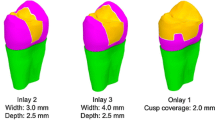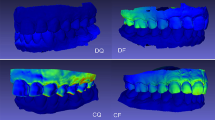Abstract
Objectives
The interproximal interface (IPI) is the interface between two adjacent teeth, i.e., the site where forces are transmitted along the dental arch. We investigated the IPI arrangement of the human permanent dentition. Specifically, the IPI morphometrical characteristics were studied and interpreted within a biomechanical framework.
Subjects and methods
A novel in vivo IPI measurement was developed based on diversity in transillumination of Polyvinyl siloxane impression of the interproximal region. The study group included 30 subjects, aged 27, ±4.0 years. Eleven parameters were examined in each of the 26 IPIs of the permanent dentition.
Results
The IPI showed intra-arch similarity and interarch diversity between the tooth groups. The IPI shape was predominantly oval (60–100 %), yet kidney-shaped in some molars (22–40 %). From incisors to molars: the IPI increased significantly (p < 0.001) in size (1.72 to 6.05 mm2), occupied more of the proximal wall (7.8–12 %), changed its orientation from vertical to horizontal (88.66–14.80°), and was mainly located in the buccal–occlusal quadrant of the proximal wall, chiefly in the molar teeth.
Conclusions
The IPI is a product of proximal wall attrition and is dictated by the mastication forces, number of cusps, and crown inclination. IPI arrangement counteracts the adverse crowding effect of the anterior component of the mastication forces.
Clinical relevance
The IPI characteristics found in the present study provide guidelines for crown and proximal filling restorations to meet dental physiology requirements. Further, IPI determines correct tooth alignment and proximal wall stripping applied to resolve arch length deficiency.


Similar content being viewed by others
References
Ihlow D, Kubein-Meesenburg D, Hunze J, Dathe H, Planert J, Schwestka-Polly R, Nägerl H (2002) Curvature morphology of the mandibular dentition and the development of concave–convex vertical stripping instruments. J Orofac Orthop 63:274–282
Ihlow D, Kubein-Meesenburg D, Fanghänel J, Lohrmann B, Elsner V, Nägerl H (2004) Biomechanics of the dental arch and incisal crowding [article in English, German]. J Orofac Orthop 65:5–12
Southard TE, Southard KA, Tolley EA (1990) Variation of approximal tooth contact tightness with postural change. J Dent Res 69:1776–1779
Dorfer CE, von Bethlenfalvy ER, Staehle HJ (2000) Factors influencing proximal dental contact strength. Eur J Oral Sci 108:368–377
Valencia R, Saadia M, Grinberg G (2004) Controlled slicing in the management of congenitally missing second premolars. Am J Orthod Dentofacial Orthop 125:537–543
Jung YG, Peterson IM, Kim DK, Lawn BR (2000) Lifetime-limiting strength degradation from contact fatigue in dental ceramics. J Dent Res 79:722–731
Vardimon AD, Tryman Y, Brosh T (2003) Change over time in intra-arch contact point tightness. Am J Dent 16:20A–24A
Vardimon AD, Beckmann S, Shpack N, Sarne O, Brosh T (2007) Posterior and anterior components of force during bite loading. J Biomech 40:820–827
Cho HS, Jang HS, Kim DK, Park JC, Kim HJ, Choi SH, Kim CK, Kim BO (2006) The effects of the interproximal distance between roots on the existence of interdental papillae according to the distance from the contact point to the alveolar crest. J Periodontol 77:1651–1657
Papalexiou V, Novaes AB, Ribeiro RF, Muglia V, Oliveira RR (2006) Influence of the interimplant distance on crestal bone resorption and bone density: a histomorphometric study in dogs. J Periodontol 77:614–621
Martegani P, Silvestri M, Mascarello F, Scipioni T, Ghezzi C, Rota C, Cattaneo V (2007) Morphometric study of the interproximal unit in the esthetic region to correlate anatomic variables affecting the aspect of soft tissue embrasure space. J Periodontol 78:2260–2265
Shah AA, Elcock C, Brook AH (2005) Posterior tooth morphology and lower incisor crowding. Dent Anthropol 18:37–42
Braun S, Bantleon HP, Hnat WP, Freudenthaler JW, Marcotte MR, Johnson BE (1995) A study of bite force, part 1: relationship to various physical characteristics. Angle Orthod 65:367–372
Kaifu Y (1999) Changes in the pattern of tooth wear from prehistoric to recent periods in Japan. Am J Phys Anthropol 109:485–499
Zilberman U, Smith P (2001) Sex- and age-related differences in primary and secondary dentin formation. Adv Dent Res 15:42–45
Proffit WR, Fields HW, Nixon WL (1983) Occlusal forces in normal- and long-face adults. J Dent Res 62:566
Benazzi S, Fiorenza L, Katina S, Bruner E, Kullmer O (2011) Quantitative assessment of interproximal wear facet outlines for the association of isolated molars. Am J Phys Anthropol 144:309–316
Davidovitch M, Papanicolaou S, Vardimon AD, Brosh T (2008) Duration of elastomeric separation and effect on interproximal contact point characteristics. Am J Orthod Dentofacial Orthop 133:414–422
Mariath AA, Bressani AE, de Araujo FB (2007) Elastomeric impression as a diagnostic method of cavitation in proximal dentin caries in primary molars. J Appl Oral Sci 15:529–533
Oh SH, Nakano M, Bando E, Keisuke N, Shigemoto S, Jeong JH, Kang DW (2006) Relationship between occlusal tooth contact patterns and tightness of proximal tooth contact. J Oral Rehabil 33:749–753
Miura H, Hasegawa S, Okada D, Ishihara H (1998) The measurement of physiological tooth displacement in function. J Med Dent Sci 45:103–115
Oh SH, Nakano M, Bando E, Shigemoto S, Kori M (2004) Evaluation of proximal tooth contact tightness at rest and during clenching. J Oral Rehabil 31:538–545
Reinhardt GA (1983) Relationships between attrition and lingual tilting in human teeth. Am J Phys Anthropol 61:227–237
Bartlett DW, Shah P (2006) A critical review of non-carious cervical (wear) lesions and the role of abfraction, erosion and abrasion. J Dent Res 85:306–312
Crothers AJ (1992) Tooth wear and facial morphology. J Dent 20:333–341
Kieser JA, Groeneveld HT, Preston CB (1985) Patterns of dental wear in the Lengua Indians of Paraguay. Am J Phys Anthropol 66:2129
Hinton RJ (1982) Differences in interproximal and occlusal tooth wear among prehistoric Tennessee Indians: implications for masticatory function. Am J Phys Anthropol 57:103–115
Begg PR (1954) Stone age man's dentition. Am J Orthod 40: 298–312, 373–383, 462–475, 517–531
Hershkovitz I, Smith P, Sarig R, Quam R, Rodríguez L, García R, Arsuaga JL, Barkai R, Gopher A (2011) Middle Pleistocene dental remains from Qesem Cave (Israel). Am J Phys Anthropol 144:575–592
Ghom AG (2005) Textbook of oral medicine, 2nd edn. Jaypee Brothers, New Delhi
Corruccini RS (1990) Australian aboriginal tooth succession, interproximal attrition, and Begg's theory. Am J Orthod Dentofacial Orthop 97:349–357
Danesh G, Hellak A, Lippold C, Ziebura T, Schafer E (2007) Enamel surfaces following interproximal reduction with different methods. Angle Orthod 77:1004–1010
Southard TE, Behrents RG, Tolley EA (1989) The anterior component of occlusal force. Part 1. Measurement and distribution. Am J Orthod Dentofacial Orthop 96:493–500
Yomoda S, Hisano M, Amemiya K, Soma K (2004) The interrelationship between bolus breakdown, mandibular first molar displacement and jaw movement during mastication. J Oral Rehabil 31:99–109
Ward CV, Plavcan JM, Manthi FK (2010) Anterior dental evolution in the Australopithecus anamensis–afarensis lineage. Philos Trans R Soc Lond B Biol Sci 365:3333–3344
Natali AN, Pavan PG, Scarpa C (2004) Numerical analysis of tooth mobility: formulation of a non-linear constitutive law for the periodontal ligament. Dent Mater 20:623–629
Eli I, Weiss E, Kozlovsky A, Levi N (1991) Wedges in restorative dentistry: principles and applications. J Oral Rehabil 18:257–264
Acknowledgments
We wish to acknowledge the significant contributions of Dr. Beni Lea Department of Orthodontics, Ms. Ana Bahar, Department of Anatomy and Anthropology, and Ms. Ilana Gelernter, Department of Statistics. This study was supported by a grant from Fulbright Program of the United States-Israel Educational Foundation (USIEF), by Dr. Herman Schauder Memorial Endowment Fund of the Sackler Faculty of Medicine Tel Aviv University and the Dan David Foundation.
Conflicts of interest
The authors declare that they have no conflict of interest.
Author information
Authors and Affiliations
Corresponding author
Additional information
This paper was based on a thesis submitted by Rachel Sarig for partial fulfillment of the requirements towards a PhD in Anatomy and Anthropology at Tel Aviv University. Additionally, this paper was also based on a thesis submitted by Nikolaos V Lianopoulos as partial fulfillment of the requirements towards a Master in Orthodontics at Tel Aviv University.
Rights and permissions
About this article
Cite this article
Sarig, R., Lianopoulos, N.V., Hershkovitz, I. et al. The arrangement of the interproximal interfaces in the human permanent dentition. Clin Oral Invest 17, 731–738 (2013). https://doi.org/10.1007/s00784-012-0759-4
Received:
Accepted:
Published:
Issue Date:
DOI: https://doi.org/10.1007/s00784-012-0759-4




